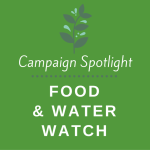ShareProgress clients are, as a general rule, pretty awesome. They run campaigns around climate change, gender equality, racial justice, and pretty much every other progressive cause under the sun. We wanted to take the time to highlight the big successes of those campaigns through a regular Campaign Spotlight feature. We’ll be asking a few questions to the brilliant campaign strategists who cook up social sharing success stories, and getting them to share their secrets.
We’re starting by talking to Sarah Alexander at Food & Water Watch. Food & Water Watch recently ran a campaign to defeat a Monsanto-backed bill in the U.S. Senate that would prohibit labeling of genetically engineered foods. The campaign (you can see it here) was shared over 29,000 times, making it one of our most successful campaigns in March. Food & Water Watch also set up A/B tests on Facebook (four test versions), Twitter (three test versions), and email (four test versions), which meant that they got some great testing insights from the success of this campaign.
Below is what Sarah told us about this campaign…
How do you decide on tests to run on your campaigns? (Is there a brainstorming period? Do multiple people work on it? What’s the process?)
Our online engagement team all use the ShareProgress tool, and we brainstorm content, share successes with each other, and iterate on content ideas based on what’s performing best from previous share pages. For the DARK act share page in particular, this was the 3rd or 4th iteration of this share content. We usually prioritize the share content for the email subject lines and the Facebook photos and headlines.
Was there anything specific you were looking to test with this campaign?
We really wanted to hone in on the image. We were seeing from previous tests that our “People at a rally” photos were not sharing well, and were being outperformed by a more generic photo with “Let me decide” on it. We realized that that may not have been descriptive enough for multiple generations of sharing, so we tested the “Monsanto” on corn photo to see if that would get closer to portraying the “Monsanto’s Dream bill” headline that we were using for Facebook content.
Why do you think this campaign in particular was successful?
The urgency was one of the key factors. The bill had just been released in the Senate, and so there was real importance and urgency for our supporters to share this. Also, the Facebook post that “won” the test had language that seems like something from a real person not an organization. I think that helps when it comes to sharing.
Have you learned anything interesting about what your audience responds to via testing?
It seems like clear, simple, conversational language does the best. Also, including the word “PETITION” so it’s really clear that it’s an action that we want people to engage with seems to beat other version when we’re testing.
Are there any tips you would pass along to organizations that are just starting to set up A/B tests?
Start with testing the things that will have the biggest impact, and just setting up two variants to get you started is pretty easy. You can test one thing to start–a headline, an image, a subject line–do what’s easiest for you. Once you get started, you’ll see that it’s not that hard to add a 3rd or 4th variant, and really start to hone in on what works for your audience.
Anything else you’d like to add about social testing and digital campaigning?
Always remember to think about creating content that is what your supporters’ friends, moms, grandmas, etc. will want to share, not just what you or your colleagues like, and test as much as possible!
Do you have a recent campaign that was a major success? Shoot me an email at anna@shareprogress.org and we’ll feature it on our blog!



Comments